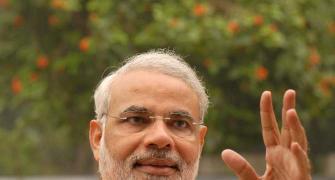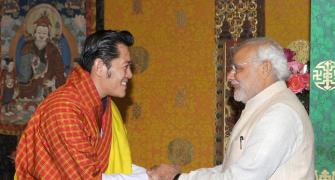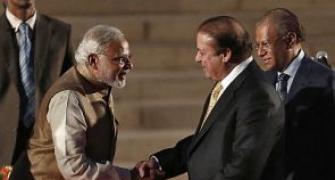 Secretiveness and the element of surprise in announcing decisions marks the Modi style of diplomacy. From being a voluble politician, he became a reticent statesman... But the diplomatic dance is performed on thin ice and his adroitness is still to be proved, says Ambassador T P Sreenivasan.
Secretiveness and the element of surprise in announcing decisions marks the Modi style of diplomacy. From being a voluble politician, he became a reticent statesman... But the diplomatic dance is performed on thin ice and his adroitness is still to be proved, says Ambassador T P Sreenivasan.
A mixed bag of triumphs and trials in foreign policy marked the first hundred days of the Modi government.
The list includes an unprecedented invitation to SAARC leaders and the prime minister of Mauritius to attend the swearing-in of the new government, a visit to India's steadfast friend, Bhutan, support to BRICS and its new bank, assertion of friendship to Russia, stress on economic and commercial ties in a meeting with the Chinese President, a signal that India would be even handed between Israel and Palestine, even while reiterating support for the Palestinian cause, meetings with three ministers from the United States, rejection of the WTO Agreement as it endangers food security plans in India, a historic visit to Nepal, an invitation to the world to manufacture in India and a decision to resume the dialogue with Pakistan and its cancellation and shying away from signing a trade agreement with ASEAN.
As he completes a hundred days, Modi has paid a game changing visit to Japan and on the cards are meetings with the leaders of Australia, China and the US.
A new comer to diplomacy, Modi has taken care to stress continuity, but without making it a fetish. He let the MEA mandarins prepare their briefs and used them to great effect in his conversations, echoing more or less the same language that Dr Manmohan Singh used.
The strategy is to appear steadfast in the consensus positions, which have evolved over the years. Instead of formulating and announcing new policies in advance, he has decided to let his thinking to evolve as he meets world leaders and measures the efficacy of the present policy.
For the present, he spoke about terrorism to Pakistan, the need for a political solution of the Tamil issue to Sri Lanka, illegal migration to Bangladesh and generally stressed the primacy of India in South Asia.
Continuity for him is an anchor, as he comes to grips with each situation and develops his own nuance for it. Like in the case of the nuclear doctrine, which the Bharatiya Janata Party had vowed to review, he has resorted to the argument of continuity and national consensus to gain time.
Modi, however, is keen to put his stamp on diplomacy. Innovation in diplomacy is already visible in Modi's moves. The invitation to SAARC leaders for the swearing in was innovative and their actual arrival was a triumph.
Distancing himself from the neighbourhood policy of his predecessors, he made the innovation that India will fight poverty with SAARC and rise with SAARC in the global arena. This is a calculated risk, given the history of the bedeviled relations that India has with several neighbours.
He tried his personal diplomacy with Nawaz Sharif, bringing in the two mothers and exchanging gifts for them. Similar innovative contacts may have been initiated with the other leaders. He is known to choose personal gifts for his counterparts.
Innovation was very much on display during his visit to Nepal. The most dramatic was his offer to Nepal to consider any change that Nepal may want to see in the Treaty of 1950. This was a way of confronting the issue squarely and finding a solution his predecessors had shied away from in the past. He succeeded to remove the deep suspicion that the Nepalese had about India's designs on their water resource.
The decisiveness, which Modi has shown in taking domestic political decisions, could be seen in his diplomacy also. After agreeing to resume talks with Pakistan, marking a departure from India's position that talks were contingent upon action against terrorists, Modi did not hesitate to call off the talks when Pakistan went back to its old ways of hobnobbing with Kashmiri dissidents.
Continuity came to his rescue when he put forward the Simla Agreement and the Lahore Declaration as the basis of the dialogue in the future. The decision to block a debate in the Rajya Sabha on Palestine even at the risk of paralysing the Upper House was a part of his decisiveness.
Equally, he did not hesitate to vote in favour of Palestine at the UN Human Rights Council, when he realised a change in Palestine policy would not be nationally acceptable in the face of the ongoing Gaza war. He stunned the Americans and the rest of the world by standing firm on the WTO issue at a time when the strategic partnership with the US was being discussed.
Secretiveness and the element of surprise in announcing decisions marks the Modi style of diplomacy. From being a voluble politician, Modi became a reticent statesman. He does not believe that he needs to explain each of his actions in diplomacy and open it to scrutiny by the press and the public.
The process of decision-making will remain private even after the decisions are announced. He made a departure from the established practice of wining and dining journalists on board his flights precisely because he did not want to be influenced by the prejudices and predilections of the press.
At the same time, he does not maintain the sphinx-like silence of his immediate predecessor. His activism in the social media has made him less dependent on the conventional media to spread his message. Messages in social media are carried without the interference of editorial scissors and pressures of time and space.
His visuals with sartorial signals like different garbs and headgears also convey a vibrant image. In other words, his silence and speeches are measured and orchestrated for maximum effect.
The Modi mystique remains even after his hundred days in office because the control he exercises on information and his continuous visibility. China and the United States may be unsure as of now what they can really accomplish in their encounters with Modi in September. They will articulate their positions on the basis of the general framework of his policy approaches, which have been outlined.
US Defence Secretary Chuck Hagel did precisely that when he outlined the co-production proposal as bait to get defence contracts. China will naturally stress investments in infrastructure and trade. Still in the stage of wooing India in the formative stage of the new government, these countries will offer the best diplomatic bargains in the days to come.
The first hundred days of diplomacy raise the hope that Modi's diplomatic talents will be an asset to him. But the diplomatic dance is performed on thin ice and his adroitness is still to be proved.
Image: Prime Minister Narendra Modi with his Japanese counterpart Shinzo Abe in Tokyo. Photograph: MEA India/Facebook.
T P Sreenivasan is a former Ambassador of India and Governor for India at the IAEA; Executive Vice-Chairman, Kerala State Higher Education Council and Director General, Kerala International Centre. You can read his earlier columns here.








.jpg)
